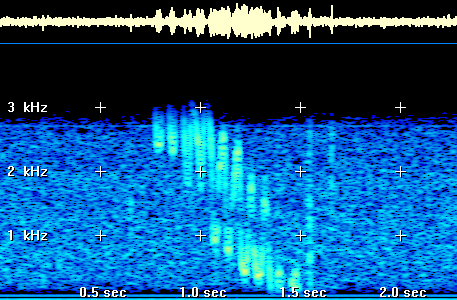
Anyone who has operated on HF for any length of time has probably heard these emissions. I have dubbed them "Squiglies" due to the sound that make when using a product detector in a receiver (SSB or CW) and the pattern they make on a spectrogram (see below). They are narrow band signals that sweep across a band in a very erratic manor. They mostly occur in the upper half of the HF spectrum (14 to 30 MHz). On 10m (28 MHz), they are very frequent. I recorded the emissions below on November 8, 1999 at 14 MHz during a geomagnetic storm.
I have noticed that the number of emissions increase and the frequency range at which they can be heard lowers when geomagnetic activity increases. Often times during a geomagnetic storm and when absorbtion levels are high these emissions are very numerous and can be heard down to at least 14 MHz.
I have been unable to find any theory or official reference to these emissions. I suspect they are somehow generated by the interaction of high speed protons from the sun interacting with the Earth's magnetic field.
A good time to listen for these emissions is a few days after a major solar flare when absorbtion levels in the ionosphere rise to high levels. During this time geomagnetic storms are common, that is, the Earth's magnetic field wiggles like a bowl of jelly due to the shock created by the blast of protons from the sun after a solar flare.
